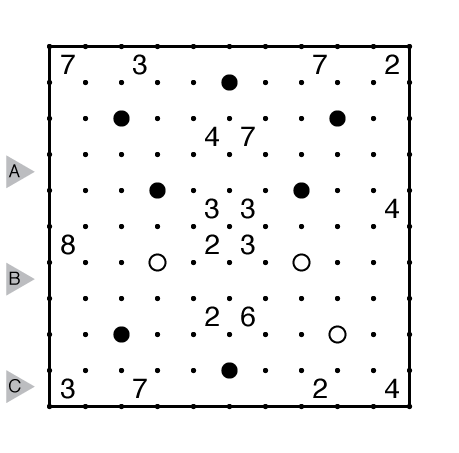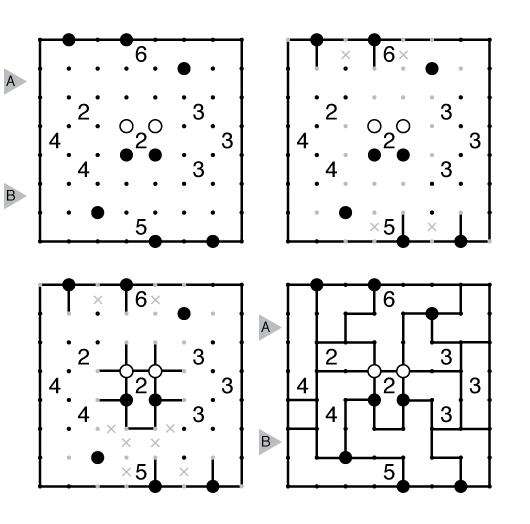Heavy Dots by Prasanna Seshadri

or solve online (using our beta test of Penpa-Edit tools in a composite mode for line/edge drawing.)
Theme: Clue Symmetry and Logic
Author/Opus: This is the 22nd puzzle from our contributing puzzlemaster Prasanna Seshadri.
Rules: Draw vertical/horizontal lines between dots to divide the grid into regions. A region may contain at most one number, equal to the area of the region. No region may cover a 2×2 area. Some dots are “heavy” and have 3 or 4 lines connected to them. Black circles indicate heavy dots with exactly three lines; white circles indicate heavy dots with four lines. Not all heavy dots are given, but there can be no heavy dots orthogonally adjacent to the indicated ones. In other words, there may be only 2 lines from any unmarked dot adjacent to a white/black circle (these dots are gray in the example).

Answer String: Enter the length of groups of white cells in the same area in the marked rows. For this example, the answer is “11212, 1132”
Time Standards (highlight to view): Grandmaster = 8:30, Master = 14:00, Expert = 28:00
Solution: PDF; a solution video is available here.
Note: This is a new puzzle style, so it is recommended to carefully review and solve the example first to get used to the thinking and all the rules.

Took a while to get used to the logic here. I’m still not sure the best solve path on the left half of the board.
Okay, it helps to remember the no 2×2 rule. That made everything a lot easier. Couldn’t understand what I was missing. I might try it again to see if that gives an easier way to get past the opening with that rule.
Yeah, that went much better. Of course the foreknowledge of having solved helped a lot.
I guess in these rule settings you could replace the no 2×2 rule with “every dot has at least two lines connected to it” as it’s mainly about line segments connected to dots.
Indeed – that is a point I made in the solution video I put together for this puzzle. Prasanna’s original rules were about no 2×2 region sizes so I kept them that way for this Saturday puzzle so that having order 2+ vertices would be something solvers would have to deduce.
I still managed to forget the 2×2 rules despite of it being highlighted.
11:50.
I feel the “no heavy dot adjacent to givens” is not natural, so I’m not particularly fond of this genre. Perhaps instead of that rule, give dots to mark whether there are two, three, or four lines extending from the dot (thus this puzzle can be easily modified by giving a two-line dot at all dots adjacent to the given dots).
The puzzle itself flows pretty smoothly though; perhaps only being terribly unused to the genre gives the long time targets.
Yeah, Thomas pointed this out too, but I thought I’d let it stay for the first time, because I originally based it on the “heavy” dots. I’ll probably consider different presentations if we revisit the genre later.
Thanks for your comment; as Prasanna mentioned this was my initial reaction to the puzzle and I specifically told Prasanna that I marked the adjacent vertices on paper before starting to solve. While I didn’t have a 2×2 square problem, that was another thing our testing and now live solving shows that a rules change might fix to make the puzzle’s logic feel more natural. We will definitely keep these comments in mind if we present this style again.
I liked this one a lot.
Now, it doesn’t matter how carefully you write the rules, I will still somehow misread them. 🙂 In this case I was so transfixed by the bolded statement about 2x2s that I managed to miss “A region may contain at most one number.” So I approached the solution without applying that rule…
…and still came up with the intended answer. I think maybe that despite the potentially paired threes and sevens, the constraint happens not to be needed for this particular puzzle? (Or can someone prove me wrong?)
I agree that the “dots adjacent to indicated heavy dots cannot be heavy” rule feels unnatural, but it did not get in the way of my solving the puzzle fluidly. I would love to see more of these!
This was a suuuuper non-intuitive puzzle type for me. Got through it, but man it was a grind. (My biggest problem was not the 2×2 rule but remembering that there were regions without numbers.)